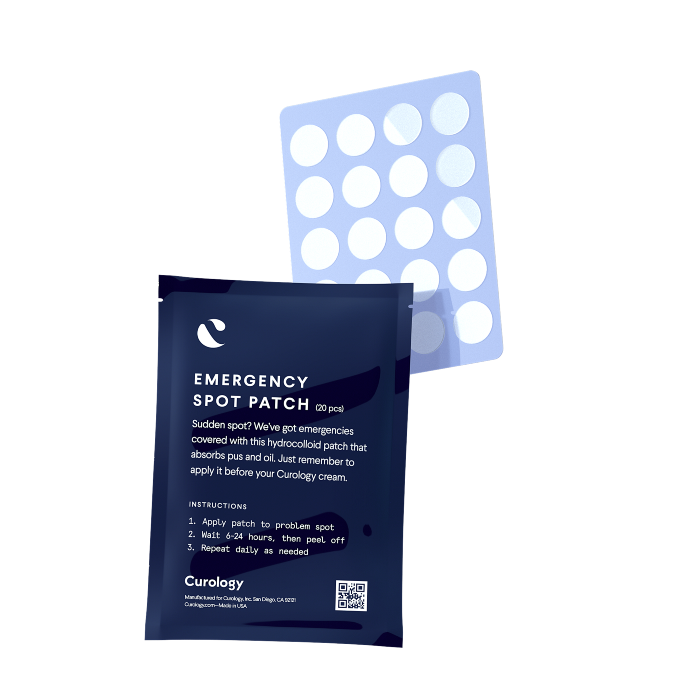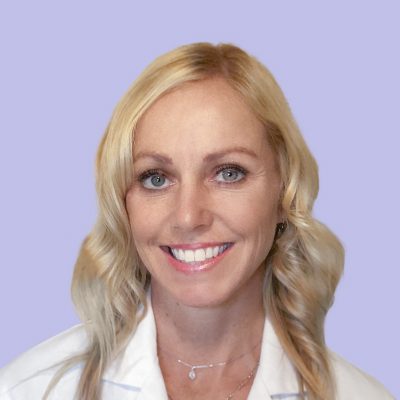How it works:
Share your skin goals and snap selfies
Your dermatology provider prescribes your formula
Apply nightly for happy, healthy skin
How it works:
How it works:
Share your skin goals and snap selfies
Your dermatology provider prescribes your formula
Apply nightly for happy, healthy skin
How it works:
Tired of painful cystic pimples?
Take our quiz to get a personal fix!
How to shrink a cystic pimple
Here’s how to help get rid of zits deep beneath the skin.



Cystic acne is red, inflamed, and painful. These lesions aren’t just uncomfortable—they also tend to linger longer than a typical whitehead. But shrinking a cystic pimple without squeezing, popping, or picking is possible! Here we’ll explore the different types of deep acne lesions and share some ways for shrinking them. We’ll also cover contributing factors and the most likely places these so-called super zits form.
Understanding cystic acne
The Curology team put together this quick video to help explain cystic acne, pore-clogging ingredients, and treatment options. Spoiler alert: Some of the same ingredients that help treat and prevent acne can also help reduce the appearance of acne scarring.
Types of cysts
Cysts are round, dome-shaped lumps under the skin. They may or may not be visible on the skin’s surface, but most people can feel a bump under their skin. Cysts can be red, inflamed, and painful. The good news? They’re treatable! But before we jump into how to treat them, here’s what you need to know about the different types of cysts:
Blind pimple. While not an official medical term, this is a type of inflamed cyst that forms deep beneath the skin’s surface. They’re usually not visible. They’re not unnoticeable, though—blind pimples are usually painful and feel like a hard bump under the skin.
Cystic acne. This type of inflammatory acne can also develop under the skin but breaks through the skin’s surface as a larger bump that’s usually tender and sore to the touch. Cystic acne generally forms large, visually noticeable zits that usually range from pea- to dime-sized. Cystic acne often leads to scarring.¹
Sebaceous cyst. The more accurate term for sebaceous cysts is “epidermal cysts,” which may or may not be associated with acne. Sebaceous cysts can form anywhere on the body but often occur on the face, neck, and torso.² They’re slow-growing lumps filled with thick, yellow liquid or semiliquid material and unlike acne have a distinctive sac. Small sebaceous cysts aren’t usually painful, but larger cysts can be uncomfortable. And depending on their location, larger cysts can cause pressure.
3 contributing factors to cystic acne
Pores become clogged with excess oil and dead skin cells. Acne-causing bacteria feed on excess sebum, causing an inflammatory response. This can lead to an inflamed, infected, red bump—aka a blind pimple (without puss) or cystic acne (with puss).³
Age. During puberty, the body produces more androgen, a male sex hormone that causes the skin to produce more sebum (oil).⁴
Genetics. A family history of acne is linked to earlier onset (before puberty) and more severe acne.⁵
Hormones. Hormonal fluctuations resulting from things such as menstruation, pregnancy, menopause, or hormone replacement therapy can cause your body to produce excess sebum.⁶
Where does cystic acne develop?
Cystic acne (and blind pimples) can occur in several places on the body except the hands and soles of the feet. But some areas are more susceptible to breakouts because they contain more oil glands. These include:
Back
Chest
Shoulders
Face and neck
How to get rid of cystic pimples
Cystic acne can be treated with prescription acne care and symptoms can be managed with certain products and home remedies. Let’s discuss some treatment methods below!
Methods to help clear up cysts
Hydrocolloid bandages. Hydrocolloid bandages (aka pimple patches, zit stickers, or acne dots) help draw out the white gunk clogging pores. They help speed up the healing process, too. Some spot treatments (like the Emergency Spot Patch by Curology) are ultra-thin, so you can cover up pimples while helping them heal faster.
You can get emergency spot patches delivered straight to your door by adding them to your Curology subscription. If you’re not a Curology member yet, don’t worry—you can also find them online here.

Warm compress. A green tea bag or other compress soaked in warm water may help soothe your cyst. The polyphenols in green tea have been shown to have anti-inflammatory and antimicrobial properties.⁷ But be careful! Burning your skin with a piping-hot compress might make matters worse. Be sure to wait for your compress to cool enough so that it’s still very warm but not hot enough to cause discomfort. The American Academy of Dermatology (ADD) recommends applying a warm compress three to four times daily for 10-15 minutes.⁸
Cold compress. A cold compress may help decrease inflammation, but avoid putting ice directly on your skin. Wrap an ice cube in a clean, thin, soft cloth or paper towel. A chilled green tea bag is another great option. Apply the compress for five to 10 minutes, repeating twice with at least 10 minutes between sessions.
Advil. Non-steroidal anti-inflammatory drugs (NSAIDs) such as Advil can be taken by mouth as directed to help decrease the swelling and tenderness of your cyst. It’s not a topical treatment, but it can make you feel a lot more comfortable!
Cortisone. If you need a cyst gone fast, or if your cystic pimple won’t go away, you can visit a licensed healthcare provider (such as a board-certified dermatologist) for an injection of a diluted cortisone medication. They’ll inject the medication directly into the cyst, helping to shrink it down in size.
Prescription skincare (like Curology!). The optimal way to treat cystic acne and blind pimples is to avoid them in the first place. Dermatologist-designed prescription skincare works to treat and help prevent acne using active ingredients like tretinoin and clindamycin.⁹
While you may not be able to get rid of acne lesions overnight, you can reduce their appearance. Proper skincare is a secret weapon when it comes to treating cystic acne. Choose cleansers and moisturizers with acne-fighting ingredients, and avoid skincare products with pore-clogging ingredients that may contribute to acne.
Get custom prescription skincare for cystic acne
The best offense is a good defense, which is where personalized prescription skincare comes in. Curology was founded by a board-certified dermatologist to make skincare more easily accessible—we help take the guesswork out of your skincare routine. Our licensed dermatology providers will work with you to examine your skin, assess your skincare goals, and provide custom treatment options designed to meet your needs.
We’re experts at treating acne, aging concerns (like dark spots and fine lines), and rosacea using proven ingredients to help you get results. Our team is available to answer any skincare questions you may have and modify your formula if necessary as your skin’s needs naturally change over time.
FAQs
If you’re experiencing ongoing breakouts or inflamed acne lesions, a board-certified dermatologist or licensed dermatology provider can help. Prescription acne treatment picks up where over-the-counter treatment options leave off, especially for those with acne-prone skin.
Maybe. Some studies suggest that sugary foods¹⁰ and certain milk products, like skim milk and cheese, may contribute to acne.¹¹ At Curology, we recommend a healthy diet with a mix of protein and fresh fruits and veggies.
P.S. We did the homework so you don’t have to:
American Academy of Dermatology Association. What can clear severe acne?
Zito, P.M., Schar,f R. Epidermoid Cyst. StatPearls. (January 2022).
Institute for Quality and Efficiency in Health Care. Acne: overview. (2019 September 26).
Institute for Quality and Efficiency in Health Care. Acne: overview. Ibid.
Ballanger, F., et al. Hereditary: A prognostic factor for acne. Dermatology. (2006).
American Academy of Dermatology. Adult acne. (n.d.).
Saric, S., et al. Green tea and other tea polyphenols: Effects on sebum production and acne vulgaris. Antioxidants. (March 2017).
American Academy of Dermatology. How to treat deep, painful pimples. (2018 September 11).
Kosmadaki, M. and Katsambas, A. Topical treatments for acne. Clinics in Dermatology. (March-April 2017).
N Mahm. and Bowe, W.P. Diet and acne update: Carbohydrates emerge as the main culprit. Journal of Drugs in Dermatology. (April 2014).
Di Landro, A., et al. Family history, body mass index, selected dietary factors, menstrual history, and risk of moderate to severe acne in adolescents and young adults. Journal of the American Academy of Dermatology. (December 2012).
Meredith Hartle is a board-certified Family Medicine physician at Curology. She earned her medical degree at Kirksville College of Osteopathic Medicine in Kirksville, MO.
* Subject to consultation. Subscription is required. Results may vary.
This article was originally published on January 27, 2020, and updated on March 24, 2023.

Curology Team

Meredith Hartle, DO